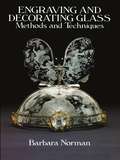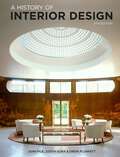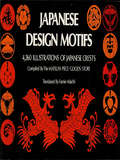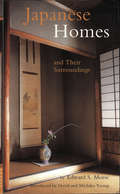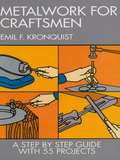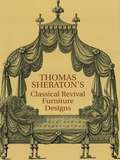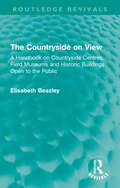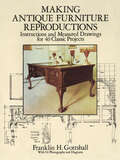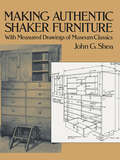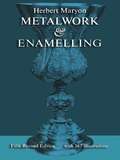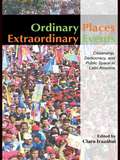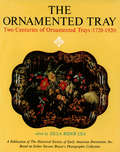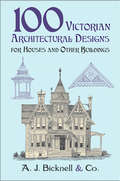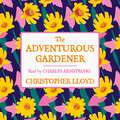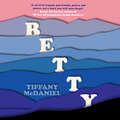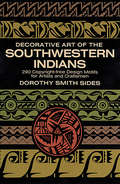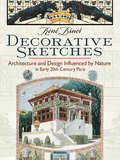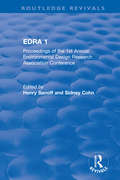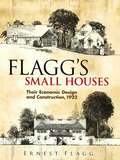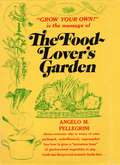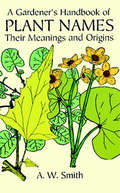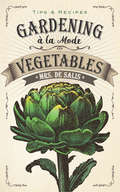- Table View
- List View
Engraving and Decorating Glass: Methods and Techniques
by Barbara NormanThe history of glass and glass decoration extends back at least to the ancient Egyptians, who made small vessels of dark glass and decorated them with glass threads of contrasting colors. Occasionally glass vessels were also engraved on the lapidary's wheel. Today, the ancient art and craft of decorating glass continues to flourish among artists and crafters attracted by its combination of artistic beauty and skilled craftsmanship. Unfortunately, until the publication of this book, there were few if any practical instruction guides for beginners in this exciting and deeply rewarding field.A well-known British artist and glass engraver, Barbara Norman has exhibited her glass widely and has won numerous awards. In this clear, profusely illustrated guide, she offers a comprehensive introduction to the history, materials, tools, and techniques of glass engraving and other forms of glass decoration.After introductory chapters on the development of glass, methods of glassmaking, decorating techniques and choosing glass, the author discusses various engraving techniques in detail: diamond point engraving, drill engraving, and copper-wheel engraving. Aspiring glasscrafters will also find excellent coverage of such interesting techniques as gold engraving under glass, painting glass, and applying glass to glass: mosaics, glass collage, glass fusing and glass forming. Most of the methods do not require a studio or workshop and call for relatively inexpensive materials.Ideal for the novice or moderately experienced glassworker, this well-written, easy-to-follow guide will enable glasscrafters to bring decorative beauty and artistic flair to glasses, tumblers, bowls, vases, plates -- almost any glass object. Beautiful engraved or decorated glass is perfect for personalized gift-giving or for adding a note of elegance to any home.
A History of Interior Design Fifth Edition
by John Pile Judith Gura Drew PileA History of Interior Design tells the story of 6,000 years of domestic and public space. It's an essential resource for students, professionals and anyone interested in interior design, the decorative arts, architecture and art history. It explores a broad range of styles and movements, weaving together a fascinating narrative from cave dwellings and temple architecture, through Gothic cathedrals and Islamic palaces, to modern skyscrapers and the retail spaces of the 21st-century.This fully updated fifth edition includes more on the contributions of women designers and architects, additional coverage of furniture, product design and decoration, as well as numerous examples of diverse modern styles from around the world. An extra final chapter focuses on the influence of the latest technology and current thinking on the importance of conservation and ethical sourcing.This new edition includes 730 images, over 300 of which are new or colour replacements for black and white photos.
Japanese Design Motifs
by Matsuya CompanyDefinitive catalogue of Japanese heraldic crests featuring almost unlimited variety of plant, animal, bird, and geometric forms -- everything from "wild goose" to "folding fan" to "mountain and mist," each with dozens of variations. 4,260 illustrations. "The 4,260 marvelous heraldic emblems...are delicate, interesting, and perfect." -- Lady's Circle Needlework.
Japanese Homes and Their Surroundings
by Edward MorseA classic text, Japanese Homes and Their Surroundings was originally published in 1886 by Edward S. Morse, a groundbreaking and imaginative inventor. Still considered an authoritative review of traditional Japanese architecture and landscape design, Japanese Homes and Their Surroundings contains over 300 detailed illustrations and reveals important historical and cultural sources, making it a time-tested resource for architects and landscape designers.
Metalwork for Craftsmen
by Emil F. KronquistThis book, by a master craftsman who has devoted much of his life to teaching, is an exceptionally useful handbook in the techniques of sheet metalcraft. Presenting easy-to-follow and complete instructions on pages opposite to carefully executed drawings and diagrams, he makes it possible for anyone to learn the basics of this art form and to fashion objects which are at once beautiful and useful, and which display the individual expressiveness of the maker.Beginning with fundamentals, the author lists and pictures all of the necessary tools and carefully explains basic techniques for cutting stock, annealing and heating, pickling, shallow hollowing, raising, planishing, bending and shaping, leveling, soldering and welding, making molds, pattern making, and all of the steps and processes in the fine art of chasing. There follows a series of specific projects for making candlesticks, coasters, fluted platters and bowls, beakers, pitchers, serving trays, lamps, and a host of other articles in a wide variety of designs. A selection of thumbnail sketches for further exploration is included, and complete instructions are given for finishing and oxidation.The compact and graphic method of presentation makes this an extremely handy book, and the projects contained in it will engage the accomplished craftsman as well as the amateur. The approach is consistently from the craftworker's point of view, and the description of workshop methods are clear and direct and result from the author's lifelong experience in actual work and in instruction.
Thomas Sheraton's Classical Revival Furniture Designs
by Thomas SheratonElegant 18th-century style book that was immediately successfully in England, Russia, America, British India. Complete coverage of Sheraton's most important designs: clock cases, commodes, drawing tables, library steps, chairs, other items. 98 plates.
The Countryside on View: A Handbook on Countryside Centres, Field Museums and Historic Buildings Open to the Public (Routledge Revivals)
by Elisabeth BeazleyOriginally published in 1971 The Countryside on View is a handbook which provides extensive information about the many ways in which visitors to rural areas may find out about what they have come to enjoy. A major part of it concerns small countryside centres which house information services and which are designed to give both the casual visitor and organised educational parties a deeper understanding of the place they have come to see. The book also has chapters on the techniques involved in the showing of historic monuments and buildings, from lonely cromlechs and romantic ruins to churches, house, bridges and other structures which are still in use. A pioneering work in the field of Museum Studies.
Making Antique Furniture Reproductions: Instructions and Measured Drawings for 40 Classic Projects
by Franklin H. GottshallWith this profusely illustrated guide, even beginning woodworkers can build precise reproductions of the most sought-after antique furniture -- heirloom pieces by Sheraton, Hepplewhite, Duncan, Phyfe, Chippendale, and other celebrated craftsmen. It's possible by following the simple, step-by-step procedures outlined in this expert manual.You'll learn how to construct such magnificent antiques as a Chippendale flat-topped partner's desk, Queen Anne handkerchief table, Sheraton drop-leaf dining table, Hepplewhite four-poster bed, grandfather clock, Queen Anne spice cabinet, and many more. Every step is clearly explained and illustrated, with remarkably detailed and precise construction drawings, accompanied by exact measurements. You'll even find superb photographs of the finished pieces.The book begins with an expert introduction to the fundamentals of cabinetmaking and woodworking: how to cut, square, and plane lumber; the use and care of hand tools; and then clear explanations of such processes as joinery, drawer construction, dovetailing, wood turning, gluing, bull and claw foot carving, and other wood carving details as well as how to choose the correct stock. Also included is a wealth of time-tested advice on selecting hardware, finishing, and other aspects of the craft.No matter what your level of woodworking expertise -- novice to expert -- the exceptionally precise and well-thought-out instructions and diagrams in this book will enable you to craft beautiful and authentic antique furniture you'll be proud to use and display for years to come.
Making Authentic Shaker Furniture: With Measured Drawings of Museum Classics
by John G. SheaThis splendid book describes and illustrates in detail how the Shakers designed, built, and finished their furniture and household articles. With its detailed text as well as over 250 photographs and measured drawings for over 80 classic pieces, it offers woodworkers and furniture enthusiasts a practical guide to the essentials of replicating a broad range of designs long admired for their sturdy practicality and their spare, elegant beauty.The book first chronicles and describes the Shaker movement and the Shaker way of living, worshiping, and working. It then explores the Shaker approach to furniture design (from chests and chairs to boxes and baskets), construction (including all joinery techniques), and finishing (including recipes for finishes).Three important sections of the book depict dozens of classic Shaker designs, complete with measured drawings. The designs include Shaker "smallcraft" such as a cutting board, scoop, candle sconce, peg-leg footstool and towel rack; more substantial "utility designs" such as a dough bin, cradle, dry sink, butcher block, and bonnet box; and furniture classics such as a Harvard trestle table, maple chair, lap desk, sewing chest, rocking chair, bed, settee and chest of drawers -- each in its own distinctive way defining the simple, practical grace of Shaker design.
Metalwork and Enamelling
by Herbert MaryonAll those concerned with goldsmithing, silversmithing, rare metal objects, or metal scientific instruments, or their repair or restoration will be delighted to find this bible of their craft available again in a new edition. And those interested in such work as one of the most rewarding of all avocational arts can hardly find a better guide. For this is the professional's handbook -- the standard text on the subject.The author, who, among his other achievements, was responsible for reconstruction work on the Sutton Hoo treasure in the British Museum (and was awarded the Order of the British Empire for his work), treats every aspect of the craft in detail, from basic tools to casting and enameling in separate sections. After discussing materials and tools, he provides a treatment of soldering in rare metals that is more extensive, more thorough, and richer in practical advice than can be found elsewhere. He continues into filigree work, the setting of stones, raising and shaping, spinning, repoussé work, wire twisting, hinges and joints, inlaying and overlaying, niello, alloys and stratified fabrics, enameling (including cloisonné, plique-à-jour, champlevé, bassetaille, encrusted and painted enamels), metal casting, construction, setting out, polishing and coloring, design, and assaying and hallmarking. Wherever possible, he analyzes examples of fine craftsmanship, ancient and modern, to illustrate practical aspects of the process he is explaining. Helpful hints are included on shop set-up and safety. The vastness of the author's experience in the actual work, with his authoritative knowledge of the entire field, ensures that readers of Metalwork and Enamelling are being advised and guided by a renowned expert.Over 300 figures and photographs amplify the discussion of tools, materials, and construction. Tables and standards useful to the craftsman (melting points and weights of metals, for example) are included. Notes to the photographic plates describe the objects in detail -- magnificent examples of craftsmanship throughout the ages. Both complete and concise, this book belongs close to every rare metals workshop, laboratory, museum shop, and craft center.
Ordinary Places/Extraordinary Events: Citizenship, Democracy and Public Space in Latin America (Planning, History and Environment Series)
by Clara IrazábalClara Irazábal and her contributors explore the urban history of some of Latin America’s great cities through studies of their public spaces and what has taken place there. The avenues and plazas of Mexico City, Havana, Santo Domingo, Caracas, Bogotaì, SaÞo Paulo, Lima, Santiago, and Buenos Aires have been the backdrop for extraordinary, history-making events. While some argue that public spaces are a prerequisite for the expression, representation and reinforcement of democracy, they can equally be used in the pursuit of totalitarianism. Indeed, public spaces, in both the past and present, have been the site for the contestation by ordinary people of various stances on democracy and citizenship. By exploring the use and meaning of public spaces in Latin American cities, this book sheds light on contemporary definitions of citizenship and democracy in the Americas.
The Ornamented Tray: Two Centuries of Ornamented Trays (1720-1920)
by W. D. John Zilla Rider LeaThis authoritative and definitive work contains the first formal history of antique trays every published. Each of its six chapters is written by a different authority. <P><P>They discuss:Lace-Edge PaintingThe "Chippendale" StyleTrays Ornamented with Gold LeafThe Freehand Bronze TechniquesStenciled TraysThe Country Painted TrayThe book is lavishly illustrated with more than 500 photographs, seven of them in full color, including pictures of trays prized by museums and private collectors, as well as hundreds selected from the unique photographic collection of the late Esther Stevens Brazer.
100 Victorian Architectural Designs for Houses and Other Buildings (Dover Architecture)
by A. J. Bicknell Co.Originally published in 1878, this now-rare collection of designs supplies views of a remarkable variety of modestly priced structures: houses, villas, cottages, many others. Handsome drawings of perspective views and elevations, some of which include floor plans, plus suggestions for interior design. 98 black-and-white illustrations.
The Adventurous Gardener
by Christopher Lloyd'The best informed, liveliest and most innovative gardening writer of our times' GUARDIAN'Christopher Lloyd ranks with Gertrude Jekyll and Vita Sackville-West as one of the major figures in twentieth-century British gardening' THE TIMESIn this gardening classic the forever adventurous Christopher Lloyd takes us on a tour through the garden, to encourage, to reveal and to overturn the old and accepted when experience prompts him. He advises on cuttings, pruning, the art of compromise and takes another look at Miss Jekyll. Gardening was a passion, and throughout his life he developed Great Dixter to be one of Britain's greatest gardens. For Christo gardening is nothing if not fun and - pointing out that 'to be roused into an argumentative frame of mind is in itself no bad thing' - he makes it equally stimulating and enjoyable for his readers.
Betty: The International Bestseller
by Tiffany McDaniel'NOT A STORY YOU WILL SOON FORGET' Karen Joy Fowler, author of Man Booker Prize finalist We Are All Completely Beside Ourselves'A girl comes of age against the knife.' So begins the story of Betty Carpenter. Born in a bathtub in 1954 to a Cherokee father and white mother, Betty is the sixth of eight siblings. The world they inhabit is one of poverty and violence - both from outside the family and also, devastatingly, from within. When her family's darkest secrets are brought to light, Betty has no choice but to reckon with the brutal history hiding in the hills, as well as the heart-wrenching cruelties and incredible characters she encounters in her rural town of Breathed, Ohio.Despite the hardship she faces, Betty is resilient. Her curiosity about the natural world, her fierce love for her sisters and her father's brilliant stories are kindling for the fire of her own imagination, and in the face of all she bears witness to, Betty discovers an escape: she begins to write.A heartbreaking yet magical story, Betty is a punch-in-the-gut of a novel - full of the crushing cruelty of human nature and the redemptive power of words.
Decorative Art of the Southwestern Indians
by Dorothy S. SidesThe decorative art of the Indians of the American Southwest has long been recognized as one of the most beautiful art traditions in the primitive world. It demonstrates a technical skill with simple materials, a symbolic richness, and a faculty for creating rich effects by the imaginative use of ornament that are all almost unique. Museums use Pueblo ceramics for display pieces, and modern artists and crafters have turned eagerly to the handwork of prehistoric Indian women for inspiration and working ideas.Mrs. Dorothy Sides, a noted artist and collector, has gathered together and redrawn in black and white nearly 300 examples of the finest authentic Southwestern Indian decoration that she has seen in a lifetime of study. She has not limited her selection to one period or style, however; to make her book as useful as possible, she has selected material ranging from the thirteenth century great geometric art of the Pueblos to the handcrafts carried on by the nomadic and Pueblo peoples of the present.The main emphasis of this volume is on ceramic decoration, and Mrs. Sides includes pieces from the rich archeological sites of Pecos, Sikyatki, the Mimbres, and modern Pueblo pottery from Acoma, Zuni, Cochiti, and the Hopi. She also includes designs and motifs from the basketry of the Apache, Pima, and Papago; beadwork from the Mohave; authentic Zuni masks; Hopi kachina dolls; and sand paintings and blanket designs from the Navajo. This broad coverage of beautiful ornament illustrates many different art styles to fit every situation: geometric designs based upon balanced mirror fields of design, symbolic figures of the thunderbird, and modern stylizations. All is beautiful and imaginative.Any crafter working with ceramics will find this book indispensable as a source of rich, easily used, powerful design; workers in wood, weavers, metal workers, and leather workers will find that it will enlarge their decorative resources considerably. It also offers unusual and eye-catching designs for commercial artists who wish to do work suggesting travel, handcrafts, the Southwest, or the social sciences. Individual drawings are royalty-free and may be reproduced without fee or permission.
Decorative Sketches: Architecture and Design Influenced by Nature in Early 20th-Century Paris
by René BinetAt the turn of the 20th century, artists and craftsmen throughout Europe and America were profoundly affected by a new art style that took its inspiration from nature. Generally referred to as Art Nouveau, the trend influenced all manner of creative types, from painters, illustrators, and architects to ironworkers, interior decorators, and designers of furniture and jewelry. Although broad and varied, the style is almost uniformly characterized by abstract, asymmetrical, curvilinear design. This "new art" both elevated the status of crafts to fine arts and brought objects into a harmonious relationship with their environment through the use of lines that were natural, vital, and, most importantly, organic.The decorative images in this volume, reproduced from a rare 1902 portfolio, reflect the era's exotic and imaginative approach to architecture and applied design. Sixty plates, 12 in full color and many with partial and varied color, exhibit the influence of the artwork of naturalist Ernst Haeckel on artist René Binet's designs, especially as related to Binet's "Monumental Door," prepared for the 1900 World's Fair in Paris. Illustrations reflecting the styles of Art Nouveau include a wealth of examples that range from doorbells and keys to stairways, fountains, jewelry, ceramics, and other items. Graphic designers, illustrators, architects, artists, and crafters will find this volume a rich source of ornamental ideas, authentic motifs, and design inspiration.
EDRA 1: Proceedings of the 1st Annual Environmental Design Research Association Conference (Routledge Revivals)
by Henry Sanoff; Sidney CohnOriginally published in 1970, EDRA 1 is a record of the conference proceedings of the 1st annual Environmental Design Research Association conference. The papers featured in this volume represent the proceedings of the conference and are concerned mainly with contributions of scientific disciplines towards the creation of improved methods of problem-solving environmental design, as well as understanding the nature of human responses to the environment. The papers included in this volume focus on developing models and methods towards a framework of coherence and definable structure of environmental design, with the ultimate objective of achieving an optimum environment for man. This volume will be of great interest to planners, architects and academics of urbanisation alike. Although published over 40 years ago, the book’s content is still as relevant and interesting today as it was at the time of publication.
Flagg's Small Houses: Their Economic Design and Construction, 1922
by Ernest FlaggA celebrated New York architect and designer of the city's fabled Singer Building, Ernest Flagg (1857-1947) was most famous for his skyscrapers. But Flagg was also an ardent proponent of the well-designed single-family dwelling. As this classic treatise illustrates, he devised a variety of structural economies and ingenious innovations.Filled with 526 blueprints, photographs, and other illustrations, Flagg's Small Houses embraces modular designs, the use of ridge-dormers, and saving space, materials, and costs. Flagg offers advice on every corner of the home, from the practicalities of plumbing and heating to the aesthetics of color choices and landscaping designs. Modern designers, both professional and amateur, will find this book a timeless source of advice and inspiration.
A Gardener's Handbook of Plant Names: Their Meanings and Origins
by A. W. SmithFirst compact dictionary to combine definitions of botanical names in general usage with information on their derivation and guides to pronunciation. A monumental index provides a cross-reference from some 1,800 common plant names to corresponding botanical ones. Combines thoroughness, botanical rigor, and interesting facts and lore — all leavened with touches of humor.
Gardening à la Mode: Vegetables
by Harriet Anne De SalisWhat's the best way to protect vegetables from frost? How do you dry herbs and banish slugs? There's much to learn about making the most of your backyard vegetable garden, and this handy little guide is brimming with advice for novice gardeners. Written by a popular magazine columnist of the nineteenth century, these timeless suggestions offer straightforward guidance for every step of the way, from planting, watering, and fertilizing to cooking and preserving your homegrown produce.Author Harriet Anne de Salis was an expert at counseling Victorian housewives on the domestic arts, writing commonsense manuals for everything from cooking on a budget to raising poultry and training dogs. This companion volume to Gardening à la Mode: Fruits features alphabetized entries and an index for easy reference. Even seasoned gardeners and cooks are likely to find it a source of useful hints and enduring charm.
